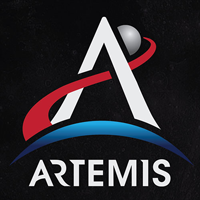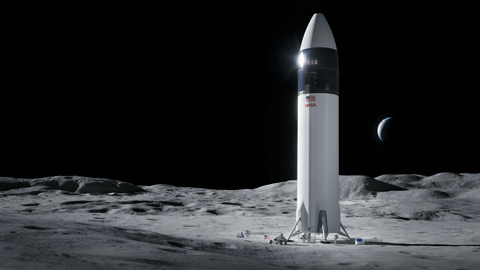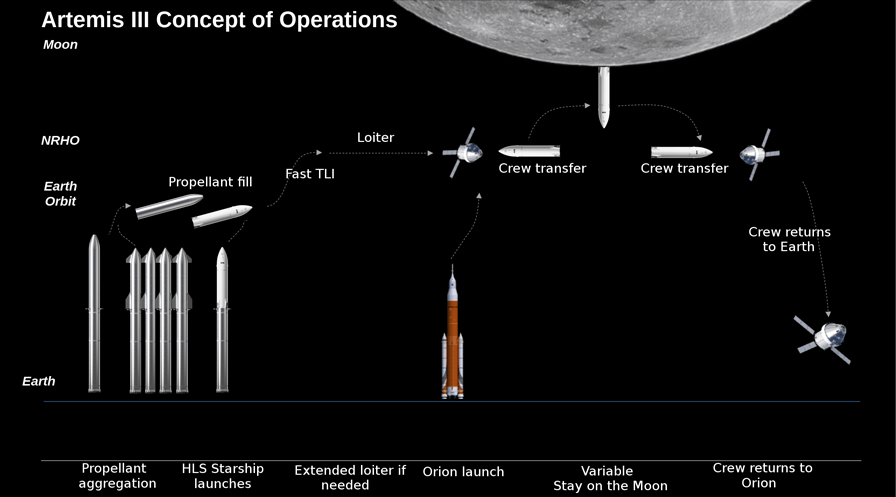On this page: Intro > Starship HLS > Uncrewed Demo > Starship vs. SLS > Winning the Contract >
Artemis Starship HLS

Returning to the Moon was inevitable. Humans were destined to reach for the Moon, our nearest solar system destination. An important part of reaching the Moon, is landing. SpaceX bid on and won the Artemis contract for the human landing system. This page is dedicated to SpaceX Lunar Starship, also called, SpaceX Starship HLS because the lunar Starship is NASA's Human Landing System.

Starship Human Landing System
Yes, SpaceX seems like a natural for landing humans on the Moon, due to the efforts made by Elon Musk and many others in their persistence to building a reusable rocket and spacecraft capable of launching humans and cargo to ISS.
NASA used Option B of their contract with SpaceX, to fund changes to Starship HLS lander system to support the new requirements (working with the Lunar gateway) and a second crewed demonstration mission.
Starship HLS Design
Starship HLS uses ~24 midbody oxygen-methane thrusters to land on the lunar surface. It will be capable of remaining 100 days in lunar orbit. Its mass will be ~100 tons when landing on the surface. It will have a 100 ton lunar upmass although the NASA requirement meant for the lander to be less than 1 ton. Starship HLS will be able to support a greater number of extravehicular activities (EVAs) or moonwalks on the lunar surface than the minimum required by NASA. There will be fuel left over after landing that can be used if it becomes necessary to do an emergency ascent from the Moon. Starship HLS includes an elevator required to go from the crew cabin to the surface because it is a very tall lander. The elevator design is fault-tolerant and designed to operate in lunar conditions.
Most of the above information comes from Wikipedia and detailed technical information is very hard to find. This page will be updated with more details as they come out. If you want to learn more you could try going to NASA's site and find out how little they've really put out as I did - - Astra

Starship Uncrewed Lunar Lander Demo
In 2022, NASA announced that it wanted a second lander and required SpaceX to launch a demo landing mission to be launched before committing the lives of four astronauts on a dangerous space mission. The Starship HLS used for the technology demonstration will not need to launch from the surface, so it can remain on the lunar surface for future use. Under the terms of the contract, this spent vessel will belong to SpaceX.
Starship vs. Space Launch System (SLS)
While the SpaceX Starship continues under development in Boca Chica, the Starship HLS variant is a bit different from the Starship intended to launch humans into the outer solar system. Starship HLS variant will launch using Raptor engines, and go into low Earth orbit (LEO). Starship HLS must then be refueled to take astronauts to the moon. This is important to understand when looking at Starship and comparing it to the Space Launch System (SLS). The SLS rocket launches the Orion capsule and can send it all the way to the Moon. It doesn't stop to be refueled, because it doesn't need to refuel. The Starship HLS needs an unknown number of fueling launches to load up the rockets for the Moon. The last Starship to be launched would be the Starship human lander that would take the crew to the surface. It is believed that 150 to 170 tons of fuel could be ferried to LEO per launch. This means 7 or more tanker launches are required to refuel the Starship HLS in LEO. These figures are coming from estimates made by Marcus House in his video, SpaceX's Starship Human Landing System Moon Shot - You may be surprised what is possible! The estimate for the number of launches needed to refuel the rocket is a hard number to predict because we don't know the true mass (weight) of the Starship HLS at this time. (August 2022)
And as an aside, the requirement of launching multiple tankers loaded with rocket fuel is the reason why NASA wrote a Nuclear Thermal Rocket or NTR into the Human Exploration of Mars Design Reference Architecture 5.0 (DRA 5.0). Despite the clamor of SpaceX enthusiasts, the refueling of rockets in orbit has some negative repercussions. It is dangerous and hazardous to the environment if there are mishaps. The rocket fuel is cryogenically cooled and boils off in the tanks, giving rise to yet another requirement. Of course, the tankers cannot instantly return to space, in this case they have to be recovered, refurbished and refueled. This refueling technology does not exist, it isn't proven, and it is a critical milestone. This means it is a possible show stopper. Having stated this, I have no doubt that we will some day have fuel depots in space.
(Yes, I know I'm raining on your parade, but I can't help it, gravity sucks. We are trapped at the bottom of the deep gravity well, supported by a precious thin atmosphere, and protected by a robust magnetic field. - - Astra ).
NASA has funded a lot of SpaceX work that annoys some people, but I don't understand why because SpaceX ponies up a lot of their own money to develop the technology they want to develop.
+ Check out NASA's About Human Landing Systems Development

I've seen many comments over the years, complaining about SLS that are understandable. Yes, it was an expensive launch system to build and as of this writing still must prove that it will work. Many comments complain about the fact that NASA is going to trash the RS-25 engines that power the first stage of SLS. The typical comment is, "what a waste". But is it?
It is important to understand that the RS-25 engines were developed in the 1970's. Yes, that's correct, they were developed over 40 years ago. They were developed to launch the Space Shuttle into low Earth orbit.
So Artemis-1 launched with the following engines:
RS-25 Engine #2045 flew on 12 shuttle missions from 1998 through 2011.
RS-25 Engine #2056 flew on 4 shuttle missions from 2001 through 2006.
RS-25 Engine #2058 flew on 6 shuttle missions from 2007 through 2011.
RS-25 Engine #2060 flew on 3 shuttle missions from 2010 through 2011.
So why is using them one more time to launch people to the Moon such a big waste? After all, they could be rotting in the museums where the rest of the old Space Shuttle parts are on display. It would be nice if the engines could be recovered. This would add to the cost of the Artemis mission and the timeline would continue to be stretched out. These engines are at best over 10 years old, we should be glad to see them put to use again. Parts of the Solid Rocket Boosters SRBs are also utilized in the SLS design and people ask rightly why we don't retrieve them. NASA is working to enable the return of the SLS rockets to Earth in the future, so new engines would be reuseable.
The Space Shuttle was the first reusable spacecraft. If comparing Starship to any other launch system makes sense, it could be compared to the Space Shuttle. The problem with making this comparison is that the shuttle was also built in the 1970's--technology has come a long, long way since then. The Space Shuttle went into low Earth orbit. It could carry 7 astronauts who made repairs in space, launched satellites, and went to the ISS. In fact, without Space Shuttle, the large components of the station could not have been raised. And, while NASA successfully launched the Space Shuttle with large station modules, they didn't let large, spent rocket boosters careen around the Earth to land who knows where.
No doubt SpaceX's Starship HLS will be completed and used to take the next humans to the Moon. NASA and SpaceX work closely together and I am sure the launch of fuels to refuel Starship HLS will be tackled and solved. Starship itself will be fitted out with technology that will be human-rated when SpaceX takes NASA's astronauts to the Moon. I truly hope the recovery system SpaceX is trying to build will work. Catching the Falcon SuperHeavy booster on the same launch stand can make it easier to refurbish and turn around faster. It's an amazing feat of engineering that definitely comes from thinking out of the box. The pinpoint accuracy that SpaceX has demonstrated with the Falcon 9b5 recoveries is already a marvel. A launch tower that can catch a returning rocket is something I can't wait to see!
Winning the Contract
In April 2020, along with 2 other proposers, SpaceX was awarded a $135 million contract under NASA Artemis program's Human Landing System to develop a lunar-optimized variant of its Starship spacecraft. NASA plans to return humans to the moon by 2024 under the Artemis program and this award provided the funding to develop a prototype. The SpaceX proposal included in-space propellant transfer demonstrations, a technology SpaceX will have to develop for future Starship missions to the Moon or Mars. SpaceX also must complete an uncrewed lunar test landing.
In the end, SpaceX was awarded a firm-fixed price, milestone-based contract total award value of $2.89 billion on April 16, 2021. Subsequently protests were filed by Blue Origin and Dynetics and the award fee wasn't immediately received by SpaceX. It is not unusual for such protests to be filed, especially for large contracts. The Government Accountability Office (GAO) reviewed the protest claims and found that NASA did not violate procurement law on July 30, 2021. The GAO ruled in SpaceX's favor. I believe NASA chose SpaceX because of its record of delivering the products and services. The truth is that NASA did not have the budget to choose two systems, that's why they waited until 2022 to put out a solicitation asking for bids on a second Human Landing System.
A NASA contract for second human lunar landing system has been selected. It was won by the National Team lead by Blue Orgin.
#AstrasStargate #ImaRocketFan
